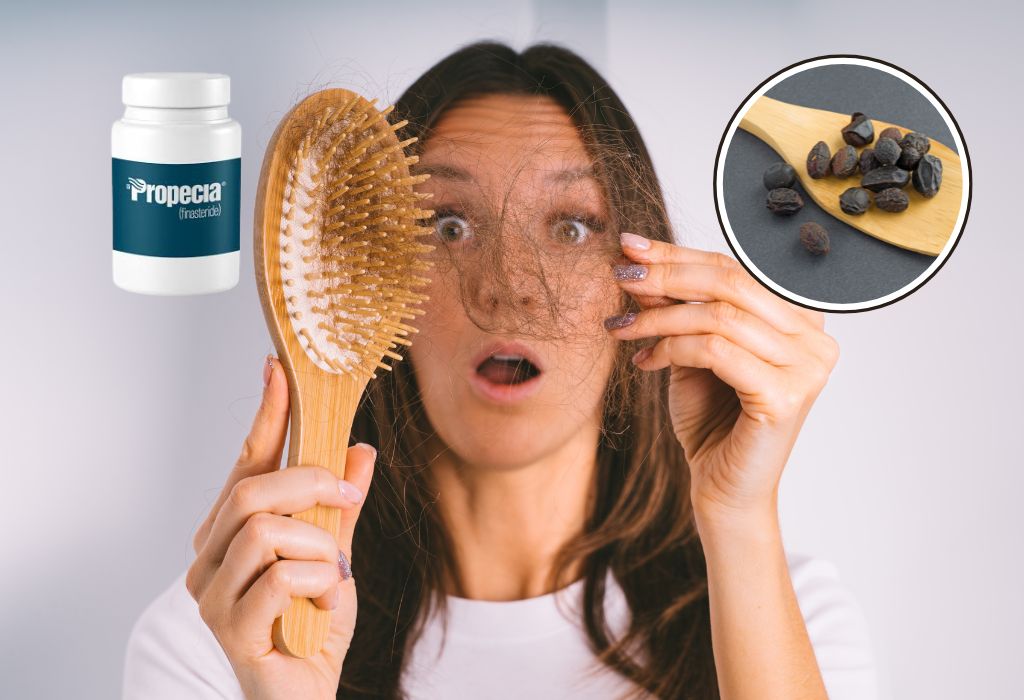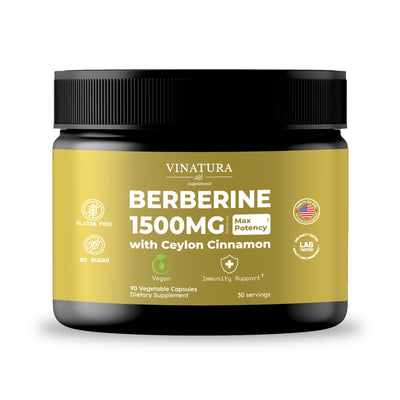
Saw Palmetto vs. Finasteride: Hair Loss in Men and Women
Hair loss has long been a distressing issue affecting everyone, not just men or women. Today, numerous solutions have been developed to tackle this concern, among which Saw Palmetto and Finasteride stand out prominently.
Among the two, Finasteride has shown superior and well-documented effectiveness in managing hair loss, particularly beneficial for men. On the other hand, although somewhat less potent, Saw Palmetto emerges as a natural alternative more suitable for women.
Beyond reducing hair loss, it also offers additional benefits such as improving skin health and regulating female hormones.
In this article, we will delve deeper into the benefits, characteristics, properties, and true efficacy of both options.
Before exploring further, please read the disclaimer located at the end of this webpage.
Key Takeaways
- Finasteride has been studied in the context of male pattern baldness and is frequently prescribed by physicians based on available clinical data.
- Saw Palmetto operates through a similar mechanism as finasteride but is a natural alternative that also supports hormone regulation, particularly beneficial for women.
- Both demonstrate relatively good safety profiles; however, finasteride carries a higher risk of sexual side effects in men.
- Choosing between Saw Palmetto and Finasteride depends on gender, specific health needs, and the severity of hair loss.
About Saw Palmetto
What Is Saw Palmetto?

Saw Palmetto (Serenoa repens) is a small palm native to the southeastern United States. The berries of this plant are commonly used in dietary supplements aimed at supporting hormone balance and prostate health [1].
One notable application is its potential in managing hair loss, particularly for those suffering from androgenetic alopecia—hair loss driven by hormonal imbalances influenced by factors such as stress, environment, and diet. We will explore this in more detail in the sections that follow.
What Are the Health Benefits of Saw Palmetto?
As previously mentioned, Saw Palmetto offers several health benefits, especially in hormone balancing and prostate function improvement. These benefits are backed by scientific evidence:
First, its efficacy in reducing hair loss:
A randomized, double-blind, placebo-controlled study evaluated the effectiveness of VISPO™—a standardized saw palmetto extract (containing 2–3% β-sitosterol and ≥85% fatty acids)—on 80 men and women with androgenetic alopecia (AGA).
After 16 weeks of oral supplementation, the group taking VISPO™ experienced a 29% reduction in hair shedding, a 5.17% increase in hair density, and no serious adverse effects were reported (Heggar, et al., 2023) [2].
While many variables influence hair regrowth and shedding, the study undeniably highlights the promising effects of saw palmetto.
Second, it significantly improves prostate health, particularly in benign prostatic hyperplasia (BPH):
A randomized study conducted in India on 99 participants found that Saw Palmetto substantially decreased IPSS scores (International Prostate Symptom Score), improved urinary flow rate, and reduced post-void residual volume, all while causing only minor side effects such as abdominal discomfort in some participants (Sudeep, et al., 2020) [3].
Third, it shows notable benefits for women's health:
A Japanese study conducted over 12 weeks with 76 women supplementing with saw palmetto extract reported improvements in urinary symptoms without serious side effects (Yamada, et al., 2022) [4].
Additionally, Saw Palmetto may support in managing PCOS, and restore hormonal balance and may serve as an adjunct therapy for managing symptoms of polycystic ovary syndrome (PCOS) (Zeng, et al., 2022) [5].
Read more: Saw Palmetto vs Maca: Which is Better for PCOS in Women?
Is Saw Palmetto Safe for Health?
Based on current research, saw palmetto appears generally safe for short-term use at recommended dosages. Reported side effects are minimal and primarily include nausea, diarrhea, or mild abdominal pain.
Rarely, some individuals experience headaches, dizziness, or blood pressure fluctuations, although these are not common. Notably, there is insufficient data regarding its safety for pregnant or breastfeeding women, and thus its use in these groups is not recommended.
Additionally, users should be aware that Saw Palmetto may interfere with PSA (Prostate-Specific Antigen) test results, which could impact prostate cancer screenings. Therefore, patients should inform their healthcare provider if they are using saw palmetto prior to testing.
About Finasteride

What Is Finasteride?
Finasteride is a prescription medication classified as a 5-alpha-reductase inhibitor. It works by blocking the conversion of testosterone into dihydrotestosterone (DHT), a hormone associated with hair loss and benign prostatic hyperplasia (BPH).
The U.S. FDA has approved Finasteride for two primary indications:
- The treatment of male pattern baldness (androgenetic alopecia)
- The treatment of benign prostatic hyperplasia (BPH)
Finasteride is commonly available in two oral dosage forms: a 1 mg/day dose for hair loss (marketed as Propecia) and a 5 mg/day dose for BPH (marketed as Proscar).
What Are the Health Benefits of Finasteride?
Finasteride’s two clinically validated benefits are: (1) treating hair loss and (2) treating benign prostatic hyperplasia (BPH). In terms of mechanism and therapeutic effects:
For hair loss:
Finasteride inhibits the enzyme 5-alpha-reductase, thereby blocking the conversion of testosterone into DHT, the androgen responsible for androgenetic alopecia in genetically predisposed men.
Clinical data demonstrate that in men suffering from vertex hair loss, global photographic assessments showed improvement in hair growth in 48% of men after one year and 66% after two years of Finasteride use, compared to just 7% improvement with placebo at both time points.
Additionally, hair count analysis indicated that 83% of men using Finasteride experienced no further hair loss after two years, compared to only 28% of men on placebo (McClellan, et al.) [6].
For benign prostatic hyperplasia:
Several studies support Finasteride's positive effects on BPH. For example, a large study involving 9,253 healthy men showed that Finasteride reduced the risk of developing clinical BPH by 40% over an average follow-up of 5.3 years (Parsons, et al. 2012) [7].
Finasteride also offers additional benefits such as increasing maximum urinary flow rate, reducing prostate volume, and significantly lowering the risk of acute urinary retention by up to 57% and the need for surgery by 40% compared to placebo (Marberger, et al. 1998) [8].
Is Finasteride Safe for Health?
Overall, Finasteride is considered generally safe; however, several potential adverse effects have been documented in reputable sources:
- Allergic reactions—skin rash, itching, hives, swelling of the face, lips, tongue, or throat
- Breast tissue changes, new lumps, redness, pain, or nipple discharge
- Chest pain or sensitivity
- Changes in sexual desire or function
It should be noted that this list may not include all possible side effects. It is crucial to contact a physician for medical advice regarding any adverse effects experienced while using Finasteride.
How Do Saw Palmetto and Finasteride Work for Hair?
Both Saw Palmetto and Finasteride have been studied for their interaction with the 5-alpha-reductase enzyme, which plays a role in converting testosterone into dihydrotestosterone (DHT).
Elevated DHT levels are associated with hair follicle miniaturization, a common characteristic observed in androgenetic alopecia.
While Finasteride is a pharmaceutical agent known for its stronger inhibition of this enzyme, Saw Palmetto has been investigated as a botanical compound with milder activity in similar pathways.
Some research suggests that Saw Palmetto may influence androgen signaling and hormone-related pathways, which could be relevant in certain physiological contexts.
For instance, studies have explored its potential role in modulating hormone profiles in women (Grant et al., 2022) [9].
It is important to note that Finasteride is an FDA-approved prescription medication intended for specific conditions, whereas Saw Palmetto is a dietary ingredient that continues to be explored in clinical and preclinical settings for its broader biological effects.
Saw Palmetto Vs Finasteride: Which is Better for Hair Loss?
When comparing Saw Palmetto and Finasteride for hair loss treatment, it is crucial to face the facts:
Finasteride has a much stronger scientific foundation regarding efficacy. Finasteride (marketed as Propecia) was approved by the U.S. FDA as early as 1997 for the treatment of male pattern baldness (androgenetic alopecia), supported by numerous long-term studies demonstrating outstanding results, as previously mentioned.
Conversely, Saw Palmetto is a natural herbal extract, best viewed as a milder alternative, particularly suitable for women experiencing non-genetic hair loss or individuals who cannot tolerate prescription medications.
Recent studies have indicated that Saw Palmetto can enhance scalp DHT density, improve hair quality, quantity, and density, and sustain results over the long term (Marks, et al., 2021) [10].
On HairLossTalk, a popular forum dedicated to hair loss discussions, many users acknowledge that Finasteride delivers faster and more pronounced results.*
However, concerns about sexual side effects are frequently raised. In contrast, although less favored, Saw Palmetto is perceived to require a longer period to achieve noticeable outcomes.*
Saw Palmetto Vs Finasteride: A Comprehensive Comparison
To gain a complete and balanced view of Saw Palmetto and Finasteride, the table below summarizes the key distinctions:
|
Criteria |
Saw Palmetto |
Finasteride |
|
Mechanism |
Mild inhibition of 5-alpha-reductase; hormonal regulation |
Strong inhibition of type II 5-alpha-reductase |
|
Primary Use |
Supports prostate health, hormonal balance, and hair growth |
Treats androgenetic alopecia and benign prostatic hyperplasia (BPH) |
|
Efficacy |
Moderate; requires extended use |
High; visible results within 6–12 months |
|
Suitable Population |
Both men and women, particularly women with PCOS |
Primarily men (not recommended for women) |
|
Side Effects |
Rare, mild, mostly digestive discomfort |
Potential sexual and psychological side effects; some hormonal changes (e.g., nipple discharge, breast sensitivity) |
|
Form |
Herbal extract |
Prescription medication |
Based on the table:
-
Effectiveness: Finasteride clearly outperforms Saw Palmetto in treating androgenetic hair loss in men, with substantial clinical evidence supporting its ability to promote significant hair regrowth. Saw Palmetto offers moderate efficacy, making it suitable for mild-to-moderate cases or individuals seeking a natural solution.
-
Safety: Saw Palmetto has a superior safety profile, with minimal risk of severe side effects, whereas Finasteride carries a low but notable risk of persistent sexual dysfunction and other hormonal disturbances.
- Target Audience: Saw Palmetto is more versatile, being applicable for both men and women (especially women dealing with hormonal imbalances such as PCOS), while Finasteride is primarily recommended for male patients.
Explore more: 5 Best Saw Palmetto Supplements for Hormone Balance
Can You Take Palmetto with Finasteride?
Currently, there are no large-scale clinical studies officially evaluating the combination of Saw Palmetto and Finasteride. Furthermore, no significant conclusions have been drawn regarding adverse effects stemming from their concurrent use.
Thus, combining these two substances does not appear to pose major safety risks and may offer additive benefits in hair loss management.
However, this does not imply that the combination should be undertaken casually. It is strongly advisable to consult healthcare professionals and rely on credible sources before attempting such combinations. Monitoring for side effects is particularly important, especially for individuals with a history of hormonal disorders.
Conclusion
In summary, both Saw Palmetto and Finasteride are effective treatments for hair loss, albeit with different mechanisms and degrees of efficacy. Finasteride, by halting the conversion of testosterone into DHT, is highly effective in stopping hair loss and promoting hair regrowth in men.
Nevertheless, it carries a risk of side effects, particularly concerning sexual function. On the other hand, Saw Palmetto offers a gentler, natural alternative, especially suitable for women suffering from androgenetic hair loss or hormonal imbalances such as PCOS.
While not as potent as Finasteride, Saw Palmetto provides additional benefits in terms of hormonal balance and overall skin health.
Regardless of your choice, remember to approach the decision thoughtfully and always seek professional advice before starting any treatment.
Testimonial Disclaimer
*The testimonials presented on this website are provided by individuals based on their personal experiences with our products. These testimonials represent individual opinions and experiences, which may not be typical or applicable to all users of our products. Results may vary depending on a variety of factors, including individual health, lifestyle, and adherence to product usage instructions.References
- [1] Shane-McWhorter, Laura. “Saw Palmetto.” MSD Manual Professional Edition, MSD Manuals, 5 Jan. 2023, www.msdmanuals.com/professional/special-subjects/dietary-supplements/saw-palmetto.
- [2] Heggar Venkataramana Sudeep, et al. “Oral and Topical Administration of a Standardized Saw Palmetto Oil Reduces Hair Fall and Improves the Hair Growth in Androgenetic Alopecia Subjects – a 16-Week Randomized, Placebo-Controlled Study.” Clinical Cosmetic and Investigational Dermatology, vol. 16, Dove Medical Press, Nov. 2023, pp. 3251–66, https://doi.org/10.2147/ccid.s435795.
- [3] Sudeep, H. V., et al. “A Double Blind, Placebo-Controlled Randomized Comparative Study on the Efficacy of Phytosterol-Enriched and Conventional Saw Palmetto Oil in Mitigating Benign Prostate Hyperplasia and Androgen Deficiency.” BMC Urology, vol. 20, no. 1, BioMed Central, July 2020, https://doi.org/10.1186/s12894-020-00648-9.
- [4] Yamada, Shizuo, et al. “Beneficial Effects of Saw Palmetto Fruit Extract on Urinary Symptoms in Japanese Female Subjects by a Multicenter, Randomized, Double-Blind, Placebo-Controlled Study.” Nutrients, vol. 14, no. 6, Multidisciplinary Digital Publishing Institute, Mar. 2022, pp. 1190–90, https://doi.org/10.3390/nu14061190.
- [5] Zeng, Ling-Hui, et al. “Polycystic Ovary Syndrome: A Disorder of Reproductive Age, Its Pathogenesis, and a Discussion on the Emerging Role of Herbal Remedies.” Frontiers in Pharmacology, vol. 13, Frontiers Media, July 2022, https://doi.org/10.3389/fphar.2022.874914.
- [6] McClellan, Karen J., and Anthony Markham. “Finasteride.” Drugs, vol. 57, no. 1, Springer Science and Business Media LLC, 1999, pp. 111–26, https://doi.org/10.2165/00003495-199957010-00014.
- [7] Parsons, J. Kellogg, et al. “Finasteride Reduces the Risk of Incident Clinical Benign Prostatic Hyperplasia.” European Urology, vol. 62, no. 2, Elsevier BV, Mar. 2012, pp. 234–41, https://doi.org/10.1016/j.eururo.2012.03.007.
- [8] Marberger, Michael J. “Long-Term Effects of Finasteride in Patients with Benign Prostatic Hyperplasia: A Double-Blind, Placebo-Controlled, Multicenter Study.” Urology, vol. 51, no. 5, Elsevier BV, May 1998, pp. 677–86, https://doi.org/10.1016/s0090-4295(98)00094-6.
- [9] Grant, Paul, and Shamin Ramasamy. “An Update on Plant Derived Anti-Androgens.” International Journal of Endocrinology and Metabolism, vol. 10, no. 2, Brieflands, Dec. 2022, pp. 497–502, https://doi.org/10.5812/ijem.3644.
- [10] Marks, Leonard S., et al. “Tissue Effects of Saw Palmetto and Finasteride: Use of Biopsy Cores for in Situ Quantification of Prostatic Androgens.” Urology, vol. 57, no. 5, Elsevier BV, May 2021, pp. 999–1005, https://doi.org/10.1016/s0090-4295(00)01052-9.
Author

Product Disclaimer
The dietary supplement products mentioned on this website are formulated based on scientific research and adhere to FDA guidelines for dietary supplements. However, the content of the articles has not been evaluated by the Food and Drug Administration (FDA) and is not intended to promote or endorse any specific product. Any products sold on this website are not intended to diagnose, treat, cure, or prevent any disease.
Opinions and Endorsements
Any claims, statements, or opinions expressed in the articles are those of the author(s) and do not necessarily reflect the views or opinions of the manufacturers of the dietary supplement products. The products sold on this website are separate from the content of the articles and are not directly endorsed or associated with the information presented here.
Liability Disclaimer
The author(s) of the articles, website, and manufacturers of the dietary supplement products do not assume any liability for any potential consequences arising from the use of the information provided in the articles. It is recommended that individuals consult with a qualified healthcare professional before making any dietary or lifestyle changes, including the use of dietary supplements.
Product Usage
Please refer to the product labels and packaging for specific usage instructions and guidelines for the dietary supplement products sold on this website.
Customer Support
For any concerns or questions regarding the dietary supplement products, please contact our customer support team, who will be more than happy to assist you.





Leave a Comment
Be the first to comment.
What do you think?